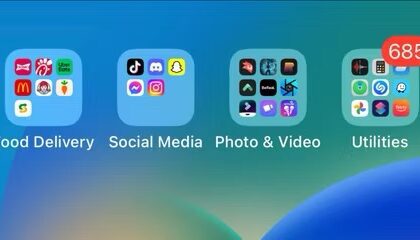Confession time: I know embarrassingly little about car repair, and I couldn’t fix a misbehaving house appliance if my life depended on it (which, on at least a couple occasions, it almost has). Heck, I can barely hang a piece of wall art without screwing something up along the way. When it comes to iPhones, though, well — I’m practically a modern-day mechanic.
Now, hang on a sec: It isn’t nearly as impressive as it sounds. I don’t have any fancy power tools or even a pair of cool-looking coveralls with my name on ’em (not yet, anyway). I’ve mostly just been using and studying iOS for a long time now — since somewhere in the mid-1800s, give or take — and when you pay close enough attention to something for a long enough period, you start to see the same basic patterns popping up time and time again.
The truth is that for as "magical" as they may occasionally appear, our sleek and shiny iPhones are ultimately just appliances. And more often than not, the issues most folks have with their iPhones are pretty darn consistent. That means whether you’re troubleshooting your own iPhone or trying to come to a struggling co-worker’s rescue, the odds are good that your problem can be addressed without too much trouble.
Consider this your guide — a collection of some of the most common complaints I hear about iPhones and the simplest solutions I suggest in those scenarios. Apply the knowledge to your own ailing iPhone or pass it on to someone else who needs it, and you, too, can experience the joy of feeling like a mobile-tech mechanic (with or without the coveralls).
What Are the Common Issues Many iPhone Users Face?
As you use your iPhone and install apps over through the years, you might encounter various problems, such as:
- Your iPhone won’t turn on
- The screen isn’t responding
- It won’t connect to Wi-Fi
- An app has become unresponsive
- The iPhone isn’t charging
- It runs slower than it used to
- iOS randomly crashes
- You can’t get past the boot up screen
So, if you encounter any of these issues—or others—don’t take your phone to the Genius Bar just yet. Try some of our basic troubleshooting steps below and see if they’ll fix your issue.
1. Charge the iPhone
It can be terrifying if your iPhone won’t turn on — especially if you’re not a tech guru. It might seem like there could be a million things wrong, and who knows where to start? Is it even fixable?
If you press the Home or Side button and your iPhone doesn’t respond at all, check if your phone is charged. One reason it won’t turn on is that someone might have borrowed your device, used it until empty, and forgot to tell you about it. Alternatively, you might have neglected the low battery sign when you put it away and totally forgot to recharge the tablet.
Also, when you’re recharging the phone, don’t just plug and leave it. Wait for the iPad to show the charging prompt before leaving it—that way, you can be sure it’s really charging and there’s no issue with the charging cable or brick.
2. Check the Lightning or USB-C Cable and Charging Brick
If your iPhone won’t charge when you plug it in, there might be something wrong with the way it’s charging. Check the phone’s Lightning port to make sure it isn’t filled with lint or debris, and inspect your Lightning cable for kinks, breaks, or frays. If necessary, swap the cable for another.
3. Close Frozen Apps Completely
Sometimes, you have to deal with an unresponsive app. If the open app doesn’t respond, you might think you’re stuck until the issue resolves itself or your phone runs out of battery. But don’t despair: you can still recover your phone. All you need to do is switch to the Recent Apps view.
If your iPhone has a Home button, double-click on it to open Recent Apps. If you have a newer iPhone without a Home button, swipe up from the bottom and pause your finger in the middle of the screen. Once done, you will return to the Recent Apps view if you have other open apps; otherwise, you’ll see your phone’s main screen.
4. Force Restart the iPhone
For cases where your iPhone has completely stopped responding to your taps and button presses, your next option is to force restart your phone. This can also help fix a variety of other bugs that might be afflicting your iPhone. There are different ways The process to force restart depends on which iPhone model you have:
- For iPhones with a home button, you’ll need to press and hold the home button along with the lock/wake button for about 10 seconds, or until you see the Apple logo.
- For an iPhone models that have Face ID, you’ll need to press the following buttons in this order: press and release volume up, press and release volume down and then press and hold the side button for roughly 10 seconds, after which you should see the Apple logo.
Whichever method you have to use, it’s important you don’t let go of the button(s) until you see the Apple logo appear on your phone’s screen.
Once your phone comes back to life, unlock it using your passcode and it should, hopefully, be free of any performance issues.
5. Check for iOS and App Updates
Although force restarting your iPhone might clear some temporary issues, some problems might crop up again if they’re caused by a persistent software bug. For this reason, you should check if either the relevant app developer or Apple has released an update for your iPhone software.
First, look at your installed apps to see if they need an update. To do so, open the App Store, then tap on your Profile Icon in the screen’s upper-right corner. In the Account view, scroll down until you see Upcoming Automatic Updates. If all your apps are updated, you won’t see it. But if you see this list, tap on Update All.
Now, to check if your iPhone has the latest iOS version, go to Settings, then tap General > Software Update. A new window will load while your device checks Apple’s servers for any new iOS versions.
If there’s a new version, you will see it under Software Update. Tap on Download and Install. Your iPhone will ask you to enter your passcode when you do that. When the download is complete, you’ll see a notification next to General in the main Settings menu. Tap on it, then tap Install Now. The phone will verify the update, restart, and install it.
6. Free Up Some Space
One factor that many iPhone users neglect is storage space. If you only have an entry-level iPhone, chances are it only has 32GB or 64GB of storage. While this may seem like ample storage at first, you’ll soon find yourself running out of space as you add photos, videos, apps, and documents.
For an iPhone to run smoothly, you should keep at least 2GB of available space. To check your free space, go to Settings, then tap General. In the General view, tap on iPhone Storage. From there, you’ll see how much free space your device has left.
We recommend that you enable the Offload Unused Apps option to offload any apps you haven’t used in a while to save space. This will remove the app while keeping all your data saved to the iPhone.
7. Reset Your iPhone’s Network Settings
Another problem that many users run into is their iPhone’s inability to connect to the internet. If your iPhone won’t connect to a specific network, but can connect to other Wi-Fi networks, then the issue might be with your router. But if it can’t connect to any network, there might be a settings error.
The best course is to reset your iPhone’s network settings. This makes the iPhone forget all connections saved on it, including any Wi-Fi passwords you saved. Reset this by opening the Settings app, then tapping on General > Transfer or Reset iPhone. In the Transfer or Reset iPhone window, tap on Reset > Reset Network Settings. Once you’ve entered the passcode, tap on Reset to confirm.
8. Reset All Settings
If any of the steps above fail to resolve your issue, try to reset all settings. This will remove any customizations you made to the settings on your iPhone, including inside any third-party apps. But, all your data and the apps themselves will remain.
You will find the Reset All Settings option in the Settings app under General > Transfer or Reset iPhone. You then need to tap on Reset > Reset All Settings to execute the command. Like the previous step’s procedure, enter your passcode to confirm your action and tap on Reset to proceed.
9. Erase All Content and Settings on Your iPhone
If you find your iPhone still not working after all the steps above, it’s time for the nuclear option—reformatting your phone. This iPhone factory reset option removes all the data on your phone: apps, movies, music, pictures, and everything else. It wipes your phone clean, making it like new. So, if you’re resorting to this, be sure to back up your iPhone to iCloud or iTunes first.
To completely erase your iPhone, go to Settings > General > Transfer or Reset iPhone, then choose the option to Erase All Content and Settings and follow the prompts on screen. Once you’ve completed the reset process, your iPhone will then return to the Hello screen from when it was new.
10. Contact Apple Support
If all else fails, download the Apple Support app and start a live chat session. The representative can walk you through more troubleshooting steps, and access device logs (with your permission) to diagnose any bigger issues.
Know Your Basic iPhone First Aid
While it isn’t likely that you’ll encounter a major error before you upgrade your iPhone, you should know how to deal with any that do crop up. That way, you won’t need to wait for a Genius Bar appointment to be able to get your iPhone working again. You can just troubleshoot it for free and fix it yourself.










